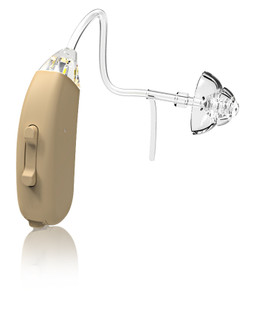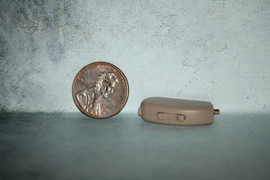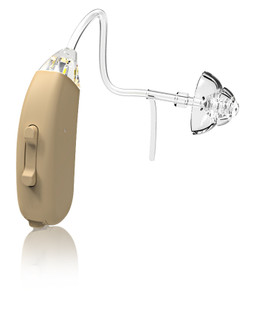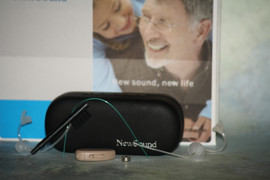Overview of Bluetooth hearing aids and how they work
Posted by DR Paul on Feb 03, 2023
Bluetooth hearing aids are the latest in hearing aid technology. Bluetooth hearing aids make it easier to connect your hearing aids with Bluetooth-enabled devices such as smartphones, TVs, and other electronic audio devices. Bluetooth Hearing Aids also provide improved sound quality and noise cancellation features for a superior listening experience.
How Bluetooth Hearing Aids Work
Bluetooth hearing aids use Bluetooth technology to connect wirelessly to Bluetooth-enabled devices. First, a Bluetooth signal is sent from the device to the hearing aid. The Bluetooth signal is then received by the Bluetooth receiver in the hearing aid and converted into sound signals that are delivered to your ears.
The Bluetooth connection between your hearing aids and Bluetooth-enabled devices allows for two-way communication. You can send audio signals from your Bluetooth device to the hearing aids, and the hearing aids can also send feedback to the Bluetooth device. This means you can control the volume of your Bluetooth device through your hearing aids, as well as adjust other settings like treble or bass.
Advantages of Bluetooth hearing aids
Bluetooth hearing aids offer several advantages that make them an ideal choice for people with hearing loss. Bluetooth hearing aids provide a more natural sound experience, as Bluetooth technology enables high-quality audio streaming and noise cancellation features. These features help to reduce background noise and improve sound clarity.
Additionally, Bluetooth hearing aids are easily connected to Bluetooth devices, allowing you to easily stream audio from your Bluetooth device, such as music or phone calls. Bluetooth hearing aids also allow for two-way communication between your Bluetooth device and the hearing aid, giving you more control over your hearing experience.
Types of Bluetooth Hearing Aids
Bluetooth hearing aids come in several different styles and designs, allowing you to choose the one that best suits your needs. Bluetooth hearing aids can be either behind-the-ear (BTE) or in the ear (ITE), depending on the style of your hearing aid. Bluetooth hearing aids also vary in terms of features, such as noise cancellation, Bluetooth connectivity, and battery life.
Different types and styles available on the market
There are a wide variety of Bluetooth hearing aids available on the market. Behind-the-ear (BTE) Bluetooth hearing aids are designed to fit behind the ear, while in-the-ear (ITE) Bluetooth hearing aids are designed to fit inside the ear canal. Additionally, some Bluetooth hearing aids come with additional features such as noise cancellation, Bluetooth connectivity, and rechargeable batteries.
Bluetooth hearing aid features
Bluetooth hearing aids come with a range of features designed to improve sound quality and provide an enhanced listening experience. Bluetooth hearing aids typically have noise cancellation technology, which reduces background noise for a clearer and more natural sound. Bluetooth hearing aids also often feature Bluetooth connectivity for easy streaming of audio from Bluetooth-enabled devices such as smartphones or TVs. Additionally, Bluetooth hearing aids often have rechargeable batteries and long battery life for added convenience.
Features to look for when selecting a device
When selecting Bluetooth hearing aids, it is important to consider the features that are important to you. Make sure to look for Bluetooth hearing aids with noise cancellation technology, Bluetooth connectivity, and long battery life. Additionally, make sure to choose a Bluetooth hearing aid in the style and size that best fits your needs.
Setting Up Your Bluetooth Hearing Aid
Steps for connecting to devices such as smartphones and other audio sources
Once you have selected a Bluetooth hearing aid, you will need to set it up in order to connect it to Bluetooth-enabled devices. Setting up your Bluetooth hearing aid is a simple process and can be done using the user manual that came with your hearing aid. To begin, you will need to turn on Bluetooth on both the Bluetooth hearing aid and the Bluetooth-enabled device. Then, you will need to pair the Bluetooth hearing aid with the Bluetooth-enabled device. Once paired, you can begin streaming audio from your Bluetooth-enabled device to your Bluetooth hearing aid.
Troubleshooting tips for common issues with Bluetooth hearing aids
If you are having difficulty connecting your Bluetooth hearing aid to Bluetooth-enabled devices or streaming audio, there are several steps you can take for troubleshooting. First, make sure Bluetooth is enabled on both the Bluetooth hearing aid and Bluetooth-enabled device. If that does not solve the issue, try unpairing and repairing the Bluetooth devices. Additionally, make sure the Bluetooth hearing aid is charged and in range of the Bluetooth-enabled device. If none of these steps resolve the issue, you may need to consult your user manual or contact a professional for assistance.
Benefits of Using a Bluetooth Hearing Aid
Improved sound quality and convenience compared to traditional devices
Bluetooth hearing aids offer improved sound quality and convenience compared to traditional hearing aids. Bluetooth hearing aids are equipped with noise cancellation technology that reduces background noise, resulting in a clearer and more natural sound. Bluetooth hearing aids also feature Bluetooth connectivity for easy streaming of audio from Bluetooth-enabled devices such as smartphones or TVs. Additionally, Bluetooth hearing aids often have rechargeable batteries and long battery life for added convenience. Bluetooth hearing aids can provide a more comfortable and convenient listening experience than traditional hearing aids.
Overall, Bluetooth hearing aids offer improved sound quality and convenience compared to traditional devices. Bluetooth hearing aids are equipped with noise cancellation technology, Bluetooth connectivity, rechargeable batteries, and long battery life for an enhanced listening experience. Bluetooth hearing aids can provide a more comfortable and convenient listening experience than traditional hearing aids. When selecting Bluetooth hearing aids, it is important to consider the features that are important to you. Make sure to look for Bluetooth hearing aids with noise cancellation technology, Bluetooth connectivity, and long battery life. Additionally, make sure to choose a Bluetooth hearing aid in the style and size that best fits your needs. With Bluetooth hearing aids, you can enjoy improved sound quality and convenience for a better listening experience.
Comfort and accessibility when using Bluetooth hearing aids with various audio sources
Bluetooth hearing aids provide comfort and accessibility when used with various audio sources such as smartphones and TVs. Bluetooth hearing aids feature Bluetooth connectivity, allowing you to stream audio from Bluetooth-enabled devices directly to your Bluetooth hearing aid. This makes it easy to access audio from a variety of sources, including music, podcasts, movies, and more. Bluetooth hearing aids also feature noise cancellation technology, which reduces background noise for a clearer and more natural sound. Additionally, Bluetooth hearing aids often have rechargeable batteries and long battery life for added convenience. With Bluetooth hearing aids, you can enjoy comfort and accessibility when streaming audio from various devices.
Overall, Bluetooth hearing aids provide comfort and accessibility when used with various audio sources. Bluetooth hearing aids feature Bluetooth connectivity, noise cancellation technology, rechargeable batteries, and long battery life for a better listening experience. When selecting Bluetooth hearing aids, it is important to consider the features that are important to you. Make sure to look for Bluetooth hearing aids with Bluetooth connectivity, noise cancellation technology, and long battery life. Additionally, make sure to choose a Bluetooth hearing aid in the style and size that best fits your needs. With Bluetooth hearing aids, you can enjoy comfort and accessibility when streaming audio from various devices.
Drawbacks of Owning a Bluetooth Hearing Aid
Potential problems related to charging, connectivity, etc.
Bluetooth hearing aids offer many benefits for users, however there are some potential drawbacks that should be considered. Bluetooth hearing aids require regular charging, which can be inconvenient if you do not have access to an electrical outlet. Additionally, Bluetooth hearing aids may experience connectivity issues if the Bluetooth signal is weak or interrupted. Bluetooth hearing aids also require frequent cleaning and maintenance to ensure optimal performance. Furthermore, Bluetooth hearing aids can be more expensive than traditional hearing aids.
Overall, Bluetooth hearing aids offer many benefits but there are some potential drawbacks to consider. Bluetooth hearing aids require regular charging and may experience connectivity issues when the Bluetooth signal is weak or interrupted. Additionally, Bluetooth hearing aids require frequent cleaning and maintenance to ensure optimal performance. Bluetooth hearing aids can also be more expensive than traditional hearing aids. Before purchasing Bluetooth hearing aids, be sure to consider all potential drawbacks and weigh them against the benefits of Bluetooth usage.
Costs associated with purchasing and maintaining a Bluetooth hearing aid
When considering Bluetooth hearing aids, it is important to factor in the cost associated with purchasing and maintaining them. Bluetooth hearing aids are generally more expensive than traditional hearing aids due to the Bluetooth technology used. Additionally, Bluetooth hearing aids require regular charging which can add to the overall costs associated with maintenance. Furthermore, Bluetooth hearing aids also require frequent cleaning and maintenance to ensure optimal performance. Bluetooth hearing aids may also require additional accessories such as Bluetooth adapters or Bluetooth receivers, depending on the device being used.
Overall, Bluetooth hearing aids can be more expensive than traditional hearing aids and require regular charging, cleaning and maintenance for optimal performance. Additionally, Bluetooth hearing aids may require additional accessories such as Bluetooth adapters.
Conclusion
Summary of benefits of using a Bluetooth hearing aid
Bluetooth hearing aids offer a range of benefits for users. Bluetooth hearing aids feature Bluetooth connectivity, noise cancellation technology, rechargeable batteries, and long battery life to provide a better listening experience. Additionally, Bluetooth hearing aids allow users to enjoy comfort and accessibility when streaming audio from various devices.
When considering Bluetooth hearing aids, it is important to factor in the cost associated with purchasing and maintaining them. Bluetooth hearing aids are generally more expensive than traditional hearing aids. Bluetooth hearing aids also require regular charging, cleaning and maintenance for optimal performance. Additionally, Bluetooth hearing aids may require additional accessories such as Bluetooth adapters or Bluetooth receivers, depending on the device being used.
Overall, Bluetooth hearing aids offer many benefits for users but it is important to consider the costs associated with purchasing and maintaining Bluetooth hearing aids in order to make an informed decision.
Note: This content is for informational purposes only and does not constitute medical advice. If you have any questions or concerns about Bluetooth hearing aids, contact your healthcare provider.










